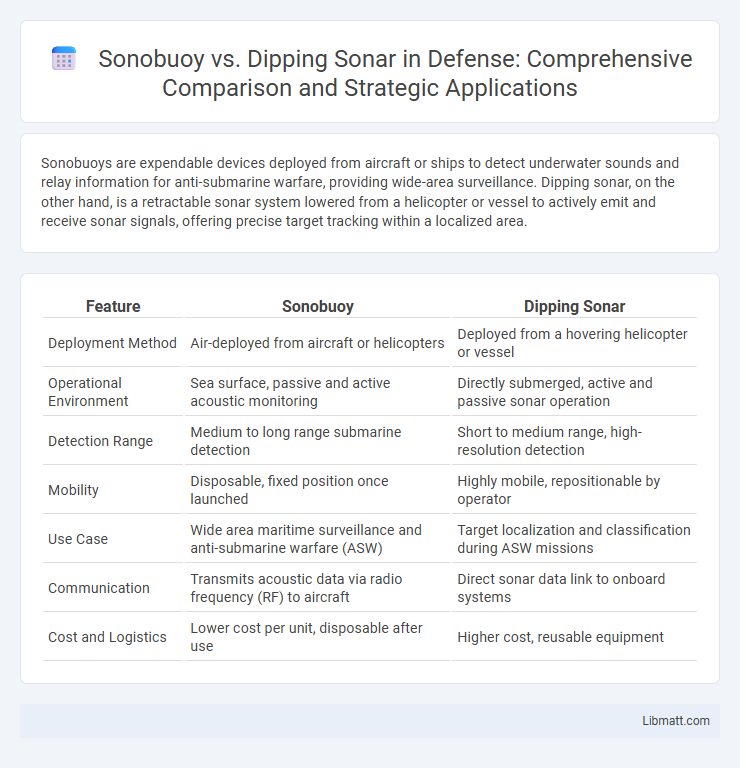Sonobuoys are expendable devices deployed from aircraft or ships to detect underwater sounds and relay information for anti-submarine warfare, providing wide-area surveillance. Dipping sonar, on the other hand, is a retractable sonar system lowered from a helicopter or vessel to actively emit and receive sonar signals, offering precise target tracking within a localized area.
Table of Comparison
| Feature | Sonobuoy | Dipping Sonar |
|---|---|---|
| Deployment Method | Air-deployed from aircraft or helicopters | Deployed from a hovering helicopter or vessel |
| Operational Environment | Sea surface, passive and active acoustic monitoring | Directly submerged, active and passive sonar operation |
| Detection Range | Medium to long range submarine detection | Short to medium range, high-resolution detection |
| Mobility | Disposable, fixed position once launched | Highly mobile, repositionable by operator |
| Use Case | Wide area maritime surveillance and anti-submarine warfare (ASW) | Target localization and classification during ASW missions |
| Communication | Transmits acoustic data via radio frequency (RF) to aircraft | Direct sonar data link to onboard systems |
| Cost and Logistics | Lower cost per unit, disposable after use | Higher cost, reusable equipment |
Introduction to Sonobuoy and Dipping Sonar
Sonobuoys are expendable sonar devices deployed from aircraft or ships to detect underwater sounds and relay acoustic data for submarine and mine detection. Dipping sonar, used primarily by helicopters, involves lowering a sonar transducer into the water to provide localized, high-resolution sonar imaging for anti-submarine warfare. Your choice between sonobuoy and dipping sonar depends on mission scope, deployment flexibility, and target detection range.
Core Principles of Sonobuoy Technology
Sonobuoy technology operates by deploying sensor-equipped buoys that detect underwater acoustic signals, transmitting data wirelessly to surface receivers for real-time analysis. These devices utilize passive or active sonar principles, with passive sonobuoys listening for sounds emitted by submarines or marine life, and active sonobuoys emitting sound pulses to detect objects through echo returns. The core advantage lies in their ability to cover vast ocean areas, providing strategic underwater surveillance without the need for continuous vessel presence.
Dipping Sonar: How It Works
Dipping sonar operates by lowering a transducer from a helicopter into the water to transmit and receive acoustic signals, detecting underwater objects or submarines in real-time. This active sonar system provides precise, localized submarine detection by actively emitting sound pulses and analyzing their echoes. Your understanding of dipping sonar's mechanics enhances strategic maritime surveillance and anti-submarine warfare capabilities.
Deployment Methods: Airborne vs. Ship-Based
Sonobuoys are primarily deployed from aircraft, allowing rapid and flexible placement over wide ocean areas for anti-submarine warfare and underwater surveillance. In contrast, dipping sonar systems are ship-based, lowered into the water from helicopters or vessels to provide localized, high-resolution acoustic detection. Your choice depends on operational requirements: sonobuoys offer area coverage from the air, while dipping sonar enables precise, real-time underwater monitoring from a platform close to the target.
Detection Range and Sensitivity
Sonobuoys typically offer a detection range of up to 30 kilometers in open water, utilizing hydrophone arrays to detect underwater sounds, making them highly sensitive to low-frequency signals over large areas. Dipping sonar, deployed from helicopters, provides a shorter detection range of approximately 2 to 5 kilometers but benefits from higher sensitivity and resolution due to proximity to the target and adjustable depth control. The extended range of sonobuoys suits wide-area surveillance, while dipping sonar excels in precise, localized detection of submarines and underwater objects.
Operational Flexibility and Limitations
Sonobuoys offer operational flexibility through rapid deployment from aircraft or vessels, enabling wide-area surveillance and adaptable positioning over large ocean zones. They are limited by battery life, signal range, and the necessity for external data processing to interpret acoustic signatures. Dipping sonar provides immediate, mobile underwater detection with precise targeting capabilities but is constrained by platform stability requirements and limited deployment duration due to power and environmental factors.
Data Transmission and Communication
Sonobuoys transmit collected acoustic data via radio frequencies to aircraft or ships in real-time, enabling immediate analysis and decision-making. Dipping sonar systems use a physical cable to maintain a direct communication link between the submerged transducer and the deploying platform, ensuring continuous, high-fidelity data transfer. Both methods prioritize reliable data transmission, but sonobuoys offer greater operational flexibility with wireless communication, while dipping sonar provides enhanced signal stability through direct cable connections.
Maintenance and Cost Considerations
Sonobuoys require periodic replacement and calibration, leading to ongoing operational expenses, while dipping sonar systems demand regular maintenance of the mechanical winch and sensor components, often incurring higher upfront and maintenance costs. Sonobuoys are typically disposable and cost-effective for short-term missions, whereas dipping sonar involves more substantial investment due to its complex hardware and integration with aircraft or vessels. Your decision should weigh the balance between recurring sonobuoy purchases and the durable but costly upkeep of dipping sonar systems.
Tactical Applications in Modern ASW
Sonobuoys provide broad area surveillance and real-time acoustic data for anti-submarine warfare (ASW) by deploying multiple sensors to detect and localize submarines over vast ocean regions. Dipping sonar offers precise, localized detection through a shipborne or airborne transducer lowered into the water, enabling high-resolution target classification and tracking in littoral and open-water environments. Combining sonobuoy networks with dipping sonar enhances situational awareness and tactical flexibility in modern ASW operations by optimizing detection ranges and improving target identification accuracy.
Sonobuoy vs Dipping Sonar: Pros, Cons, and Future Trends
Sonobuoys offer wide-area passive and active acoustic monitoring, ideal for rapid deployment and covering broad oceanic zones, but are limited by battery life and single-use design. Dipping sonar provides precise, localized detection with adjustable depth, enhancing target resolution and tracking but requires deployment from helicopters, limiting operational endurance and range. Future trends emphasize integration with AI for real-time data analysis and networked sonar arrays to improve underwater situational awareness and operational flexibility.
Sonobuoy vs Dipping sonar Infographic

 libmatt.com
libmatt.com